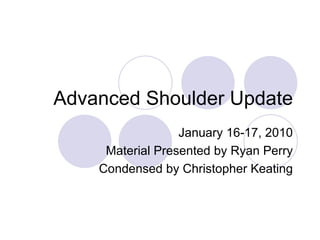Advanced Shoulder Update
- 1. Advanced Shoulder Update January 16-17, 2010 Material Presented by Ryan Perry Condensed by Christopher Keating
- 2. Anatomy Highlights GH,AC,SC,ST,T/S Upper Subscap ®C Mover Lower Subscap ®C Stabilizer Supraspinatus ®C Most prone to degeneration 8 Bursae in Shoulder 2 Bursae at Scapula ~ Scapular crepitus
- 3. Biomechanics Treat the Glide not the Roll GH OPP~ 55-70 Abd, 60 E°Ø Flex, 30 Hoz Add CPP~ Max Abd, ER, Ext CPP~ IR, Ext, Add AC CPP~ 90 Abd (Isolates the SC joint) SC CPP~ Full Elevation
- 4. Special Tests Impingement Hawkins-Kennedy Patient seated with arm and elbow flexed to 90. The examiner IR the GH compressing subacromial tunnel against the coracoacromial arch + Pain at anterior shoulder Sn 92% Sp 25% (Calis 2000) Neer Patient is seated and examiner forcefully flexes the arm with overpressue with scapular stabilization + Pain at the anterior/lateral/superior Sn 88% Sp 30% (Calis 2000)
- 5. Special Tests Impingement Cross-Body Adduction Positioned as in HK but in place or IR pt is forced into Horizontal Adduction + Pain at Anterior/Lateral Shoulder Sp 82% Sn 27% (Calis 2000) Cluster Testing Park 2005 If all 3 tests positive a Likelihood Ratio of 10.56 Strong conclusive evidence for impingement
- 6. Special Tests RTC Tear (Full) Infraspinatus MMT Painful Arc Drop-Arm Cluster Testing Park 2005 All 3 + Likelihood Ratio of 15 If over 70 than 1 + test will be 76% chance of RTC tear
- 7. Special Tests Labral Tear O°ØBrien Crank Clunk Modified Dynamic Labral Shear* Anterior ∫›∫›fl£ Anterior Load Shift 0-45-90 *
- 8. Scapular Research Scapular weakness and abnormal position have been associated with RTC pathlogy Lateral position of scapula increases pressure on anterior structures May not correct tear or fix impingement, but can correct malalignment Serratus Anterior and Lower Trap are first to be inhibited in scap mechanics Upper trap over activation common is patients with scapula malalignment
- 9. Manual Therapy Principles Effects of MT Reduced Muscle Guarding Improved Joint Mobility Increased ROM Normalized Muscle Tone Psychosocial
- 10. MTP Fix the Hinge Don°Øt Crank the Handle Avoid osteokinematic motions Shortened muscles should not be stretched in the presence of pain Inhibit tone Mobs, STM, Exercise Dose
- 11. Manual Therapy Principles Assess ®C Rx ®C Reassess Hypomobile joint treatment begins with the exam of adjacent joints Begin and End with Distraction Treat the Glide of Limitation then Range Joint Start at resting position and progress to end range
- 12. Techniques GH Distraction Anterior Posterior I, II Inferior Thoracic Mob and Manip AC Distraction I,II,III
- 13. Exercises Best ER 1) Sidelying ER without Towel 2) Prone Horizontal abd at 100 full ER To progress consider flex in place of Abduction secondary to increases tone and ant instability
- 14. Exercises Best Lower Trap 1) Prone Scaption 2) Shoulder ER at 90 Abd Also the same for middle trap
- 15. Exercises Best for Serratus Anterior 1) D1 Flexion 2) Scaption > 120 3) Scaption < 80 Upper SA Push-up with a plus Bear Hug SA Punch















